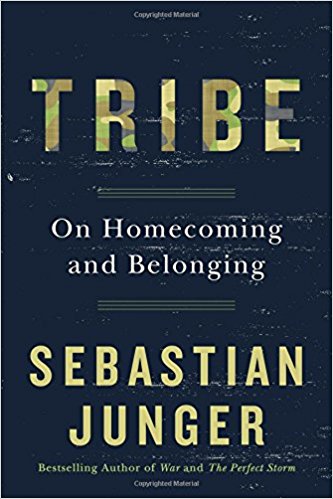 “Tribe”. Going in I found that title off-putting, especially coming from a journalist best known for his reporting of the society of the military: offhand the word “tribe” conjures for me ideas of race, segregation, warfare, and social superiority of a martial class of warriors. This book is (for the most part) not really about any of that. It is also a very quick and compelling read, although it’s a bit longer it felt like reading, say, three New Yorker pieces in a row. The editing is very tight, with interlocking themes and each paragraph pulling its weight.
“Tribe”. Going in I found that title off-putting, especially coming from a journalist best known for his reporting of the society of the military: offhand the word “tribe” conjures for me ideas of race, segregation, warfare, and social superiority of a martial class of warriors. This book is (for the most part) not really about any of that. It is also a very quick and compelling read, although it’s a bit longer it felt like reading, say, three New Yorker pieces in a row. The editing is very tight, with interlocking themes and each paragraph pulling its weight.
Instead, this is a book about grappling with the social atomization that comes along with industrialization and modern society. It could almost be a companion to Putnam’s Bowling Alone; it also brought to mind the “Rat Park” experiments that show that drug addiction is vastly increased with social isolation; and Dan Buettner’s “Blue Zone” work with National Geographic, which is about environments that make people happier, which also often involves making people more social.
Junger’s three main storytelling devices are:(())(())
(1) That people are, in a weird way, happier when there is disaster (including war), because it instantly levels social class, causes people to be less isolated, and requires people to work together towards immediate shared goals. He uses examples of how WWII British authorities thought British society might collapse when the Nazis started bombing, but in reality the Blitz brought people together, and they just figured out how to live together in bomb shelters with less crime than during ordinary life (but, failing to generalize and internalize this lesson, the Allies still proceeded to firebomb Dresden and other population centers, hardening German resolve); and of the siege of Sarajevo, which was the longest-running siege in modern military history, which many Sarajevo residents look back with mixed feelings: obviously being shelled and starving was bad, but they felt greater purpose and social unity and fulfillment. In a world that seems less stable and disaster-prone by the week, this part made me strangely hopeful to read about how, rather than looting and chaos, society often becomes more coherent in a disaster.
(2) He also compares Northern European culture to American Indian culture (Junger’s term, under instruction from an Apache interviewee), especially in the eighteenth century and in terms of happiness of those that moved from one culture to the other: many Europeans joined American Indian tribes and were super-happy about it, but there are almost zero instances of Indians adopting European culture. Europeans, especially women, praised American Indian society’s egalitarian and social lifestyle. He also makes similar comparisons to !Kung tribes in the Kalahari desert, who worked a lot less (average twelve hours a week) and generally reported higher contentedness than Western society.
(3) He goes over the various responses to PTSD based on the social environment the PTSD-sufferer returns to (this part is very Rat-Park-ish). PTSD sufferers with greater social cohesion and shared experience (like, where they can talk shamelessly about their traumatic experience) tend to recover more quickly than those that cannot. He also makes an interesting point that soldiers may have more difficulty recovering from PTSD because the experience of warfare is socially positive: it gives tribe-like coherency in a way that the society they return to does not. But at the same time, it is obviously traumatic in terms of near-death experiences, killing others, and seeing your friends killed.
Overall, if I had to sum the book up into one sentence, it would be: “Wouldn’t it be nice if we could have the social cohesion that disasters and war, without the disaster and war part?” Unfortunately, Junger doesn’t have the answer as to how we do that, but it is an interesting way of thinking about the discontentment of modern society.
Leave a Reply